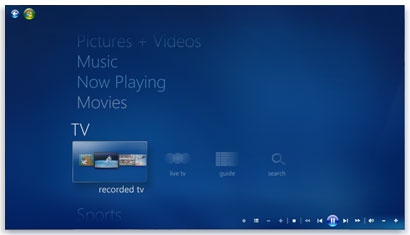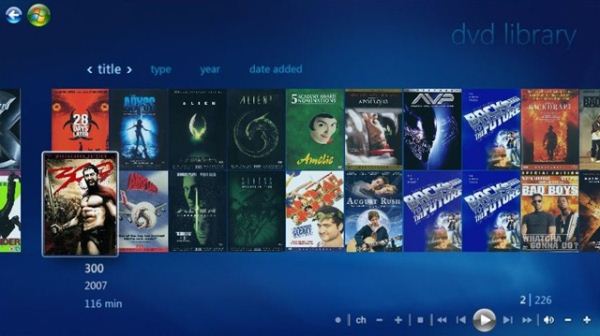Media Center for Windows 8: An Add-on At A Nominal Price
by Jason Inofuentes on May 5, 2012 10:07 PM EST- Posted in
- Windows 8
- Microsoft
- Windows Media Center
AnandTech has been covering the Home Theater PC space since those halcyon days when Windows XP Media Center was rolling out, and the era of dual-core Pentiums promised tolerable playback of DVD-quality AVI files. Despite our, and your, enthusiasm, Microsoft dropped hints throughout the product’s various iterations that Media Center’s role in Windows 8 was minimal. As the Building Windows blog was updated we saw promises that Media Center would be there, but with little in the way of details. And in their latest post, the Windows 8 team reveals the new face of Media Center.

Yeah. We know. The new Media Center is the old Media Center, wholesale. In the post regarding SKUs, the Windows 8 team announced that Media Center would not be included in any of the Windows 8 releases, but would be available for Windows 8 Pro users as an add-on. The add-on will be the same experience found in Windows 7, with no apparent additions. Why take such an apathetic approach to Media Center? Usage.
In data Microsoft published last year, Media Center was launched by 6% of Windows 7 users. For a feature to have such low usage, 10 years after it was first introduced, means that whatever efforts to gain traction have failed, and further efforts are unlikely to have great success. So, deprecating Media Center to the level of a near-orphaned feature is not surprising in the slightest. What was unexpected was the deprecation of audio codecs and DVD playback to the Media Center Pack as well. Codec licensure is something the public can generally ignore, but it’s the reason DVD players will never cost a penny, and why the original Xbox required a dongle for playback. Since Windows XP Media Center, users have been paying for MPEG-2 and Dolby Digital decode support. With Vista, the audio side was bolstered with Dolby Digital Plus, and this was maintained in Windows 7. Windows 8 will not have DVD playback out of the box, though with the addition of the Media Center Pack will gain the appropriate licensure.
News isn’t all bad on the media front for Windows 8, though MPEG-2 for the DVD containers is omitted, it is included for H.264 decoding, alongside Dolby Digital Plus support; all this intended to extend video streaming support. In the era of Ultrabooks and tablets, optical drives are on the decline, so omitting support for DVD-Video playback, and entirely ignoring BluRay support, is sensible.
We had been considering doing a quick “State of the HTPC”-style piece, with a focus on the state of MCE and what changes to expect in Windows 8. Now we know, there’s not much to expect. So, instead we’ll plan to explore what competing software has been able to accomplish, particularly MythTV; and how well the latest CableCARD experience pans out. Don’t be surprised, though, if our HTPC software of choice remains Windows 7, well into the future.
Source: Building Windows 8











99 Comments
View All Comments
mcnabney - Tuesday, May 8, 2012 - link
Didn't Microsoft extract $10 per device from Motorola for even more dubious patents? They didn't even tell them what the patents were - just pay us or we will sue. And then Motorola screamed fraud after they finally got to see what those undisclosed patents were.Screw MS.
Ultraman1966 - Tuesday, May 8, 2012 - link
I've been using Win 7 since release (well, RC) and up until a few months ago I wasn't even aware that Media Center was included in all versions! Maybe Microsoft should advertise it a bit more...?danot - Tuesday, May 8, 2012 - link
I only used Windows lately for games (mostly Steam games), and Windows Media Center. I really like Media Center, but I think I'll switch to Ubuntu + MythTV - since Media Center will be abandoned. I installed Ubuntu under Oracle's Virtual Box recently to help develop Android Apps and really like it. I'll try to use Wine to run Steam + native WIndows games.mcquade181 - Wednesday, May 9, 2012 - link
Good luck with Ubuntu and MythTV. I've tried to use it a few times and finally gave up and went back to WMC.The biggest problem with it is TV tuner driver support from the manufacturers - check out how many DVB-T dual channel tuners are supported and you will see what I mean.
Graphics drivers are also a bit average, and last time I checked Bluray support is non-existent.
skifiddle - Wednesday, May 9, 2012 - link
I haven't the time to figure it out, but I quit using Media Center when it disappeared on its own. Then later Media Player dropped out of my list of programs in Win7-64. 32 bit versions, also. May have dragged them out with no warnings.slyck - Wednesday, May 9, 2012 - link
"so omitting support for DVD-Video playback, and entirely ignoring BluRay support, is sensible"Really? What about ISOs on the NAS?(despite what fascists say about what you can do with your own legally purchased software). But I guess I don't have to care since I despised media center after giving it a fair try. No loss.
slyck - Wednesday, May 9, 2012 - link
meant to say 'legally purchased media'Disorganise - Thursday, May 10, 2012 - link
Business users don't have media centre right?Anyway, since I use WMC as my only TV 'driver' I'm sad to see this news. My WMC remote learned the volume control for my amp, and the power control for the TV - and since I have a blu-ray installed (with total theatre), I can enjoy TV, recorded TV, music, picture slideshow, DVD, DVD iso and blu-ray movies (including 3D), all with the use of a single, simple remote control.
I've just moved to Indonesia for an assignment, and whilst I wait for shipment to arrive, I'm back to using 3 remotes - TV, DVD/Amp, WMC remote 'plugged 'into the laptop. Since I've no tuner cards, watching live TV 'only' requires 2 remotes but my wife still doesn't 'get it'.
As to the argument that physical media is dead...are you nuts? In Australia it use to take 12 hours or more to download a 5GB game from Steam. How long would a blu-ray take? Versus a 10 minute walk to the local VideoEzy store. In Jakarta I alledgedly have a 1Mpbs connection, so I'm looking at 10.5 hrs to download a DVD. Streaming, I hear you say, but surely the stream still takes 10 hrs - even if the movie itself is only half the disk, it's still 5 hrs; how many movies are 5 hours? So the experience would be all stutter.
Physical media has a long future outside of the USA I think. And as to the option of downloading some xvid or similar version which is smaller - why would I want to compromise the sound and video quality when, again, I can walk to the store and get the full experience? This is especially true for blue-ray - you don't invest in a huge TV and decent sound system to then run something akin to youtube.
And fwiw - it's rare that I have two or three days notice of wanting to watch a movie. Usually it's a spontaneous decision - the 10 minute walk to the store is enough for the other half to get the wine ready :)
So in conclusion I guess I'll be sticking with Windows 7. To be honest, it's no surprise since it seems that Windows 8 is entirely tablet focussed. It's a real shame 'cos Windows 7 is really is a good OS - there's a lot of dumb crap too (like why is control panel alpabetical *horizontally* instead of vertical - I have to shrink the window toone column width to find anything) but mostly it's been reliable and fairly quick for me. I really hoped Win8 would inject something to get excited about but 6 of the 7 devices I use daily (or almost daily) are NOT tablets, and 5 of the 7 are not touch sensitive (as it happens the phone and tablet are both Android)
Wardrop - Thursday, May 10, 2012 - link
The problem with alternatives to media center, is that if there's one thing Microsoft are pretty good at, at least for their core products like Windows, it's a fairly rock-solid user experience. Everything is consistent and meets user expectations as far as the UI is concerned. It's this polish that seems to be lacking from the alternatives to media center.User experience is such a critical component of any HTPC. Most people want their HTPC to be appliance like, which normally means they want a refined experienced. Microsoft thus seems to be the only company to deliver that. That's my impression anyway.
mcquade181 - Thursday, May 10, 2012 - link
Yes I agree.MythTV is very powerful, but it's a nightmare to setup (even for an IT expert), and most importantly the "user experience" is quite poor and definately not wife friendly. The next problem is Linux and lack of tuner card manufacturer driver support (just check how many DVB-T dual channel tuners are supported). Then there's the problem of the lack of blueray support.
XBMC is not too bad as far as user experience goes, but of course there is no built in Live TV support. I do run it, but have discovered lots of small issues that the average user would have no hope resolving.
Simllarly MediaPortal is reasonable but it is still well behind WMC as far as user experience goes - the biggest issue being consistency. It is improving version by version, but in reality it has years to go.